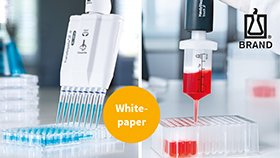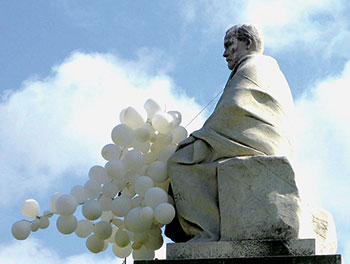Vive la France!
Career strategies for young European scientists
by Ralf Schreck, Labtimes 04/2009
Nowadays, the chances of meeting a scientist in France on the road striking and not at work are quite high. Earlier this year, far reaching reforms either announced or already put into practice by the French President Nicolas Sarkozy and his Minister for Higher Education and Research, Valérie Pécresse, provoked nationwide strikes at universities. More than a few scientists in France are against any changes and are worried about losing their status, scientific freedom or even job. Although the promotion of young scientists is on Sarkozy’s agenda, the key question remains as to whether France, in its current situation of upheaval, is able to be a stepping stone for your career.
French inventory
Whenever Sarkozy goes on stage these days, he paints a gloomy picture of the French education and research system. Is this just provocation or already frustration and fear of becoming a president lacking in assertiveness? Is the situation in France utterly devastating or is its education and research system, that has developed over centuries, not all that bad?
With respect to scientific output, there have been no major changes for the worse over the last decade. If bibliometric indicators incorporating productivity and impact are applied, France is still among the top five countries in the world in many different subject categories according to the SCImago. In the last Academic World Ranking by the Shanghai Jiao Tong University, three French higher education institutions made it into the top 100 worldwide: the Pierre and Marie Curie University (Paris 6), the Paris-Sud University (Paris 11) and the École normale supérieure Paris. The Pasteur and the Curie Institute belong to the foremost European research institutions, when it comes to infectious diseases and cancer, respectively. There are many international institutes such as Institut Laue-Langevin, which operates the most intense neutron source, or the European Synchrotron Radiation Facility, Europe’s most powerful synchrotron light source. Both share a common campus with the EMBL outstation in Grenoble and, yearly, attract hundreds of visiting scientists from all over the world. France was also the second most popular host country in the first round of the competition for Young Investigator as well as Advanced Grants of the European Research Council. Considering the number of Nobel Prize winners, France is in fourth place behind the USA, UK and Germany. Finally, Sanofi-avensis belongs to the leading pharmaceutical companies worldwide and is the major private investor in Research & Development (R&D) in France.
On the downside, according to a new OECD report, the commercialisation of research results is still weak. The patent activity is only average at the European level and the close contact of France to its competitors in expanding fields such as bio- and nanotechnology seems to be lost. The French expenditure for R&D dropped from 2.3% of the gross domestic product in 1995 to 2.08% in 2007, which still accounts for roughly 20% of the R&D spending in Europe.
The French way of doing research
The Ministry of Higher Education and Research is in charge of the French research policy. However, in addition, six ministries have competences for certain areas of research. The most important public research performers are public research organisations (PROs), such as the National Center for Scientific Research CNRS or the National Institute for Health and Medical Research Inserm. The second arm of the public research landscape is made up of higher education institutes including universities and Grandes Écoles. Funding is provided to a large extent as institutional performance-independent block funding. For many years, third party funding of research in general was low, e.g. at higher education institutes below 20% and at PROs around 10%. These numbers have been on the rise since the French National Research Agency (ANR) was established, which is backing research projects on a competitive basis.
Research in France is often performed in partnerships between higher education institutes, PROs and other research performers. The CNRS started this development with the establishment of Associated Research Units almost 50 years ago, which later became Mixed Research Units or joint labs (Unités mixtes de recherche, UMR). This type of cooperation was extended to other PROs and is realised through four-year contracts between PROs, higher education institutes and the ministry in charge of research. Currently, there are more than 1,500 UMR varying in size. Usually, there is a core team of about 10 to 20 people working within a larger network. Mixed Research Units bring together human and financial resources and infrastructure from quite different sources. This is not always without its problems and comes along with excessive bureaucracy.
The great majority of the scientific personnel at universities and PROs are tenured public servants. There are two main categories for researchers. Professors (Professeurs des Universités) and senior lecturers (Maîtres de Conférences) constitute the majority of university teachers (Enseignants-Chercheurs), whereas research directors (Directeurs de Recherche, DR) and senior researchers (Chargés de Recherche, CR) are the preponderant researchers (Chercheurs) at PROs. Dependent on age, qualification and experience, additional salary grades have an impact on the monthly pay cheque.
With some notable exemptions, research funding by foundations and academies or societies is not as well developed as in the other leading European countries. Famous private foundations are focussing on health and medicine such as the Pasteur Institutes at Paris and Lille, the Curie Institute in Paris, the Foundation Jean Dausset or the Fondation pour la Recherche Médicale.
French biomedical research was evaluated last year by an international team of high-ranking scientists. The final report stressed the already high quality of science in France and the excellent reputation of many institutions and its researchers. However, the high fragmentation of the biomedical sector was heavily criticised. For example, more than eight national institutes and governmental funding agencies provide life science programmes, which leads to redundant efforts and overflowing bureaucracy. The creation of a single National Institute for Life and Health Sciences Research was recommended. On the level of the individual scientist, the committee suggested that only the best scientists should be recruited by ensuring flexibility, mobility and competitive salaries, and that a probation period for up to five years before tenure should be installed.
University system
Starting with the creation of universities in Paris, Orléans, Toulouse or Montpellier as early as the 13th century, the French higher education system has a long tradition. During the French revolution all universities were closed but in 1808 Napoléon Bonaparte re-established the faculties and also founded the Grandes Écoles, focussing on a single narrow field, in order to educate prospective public servants. For a long time, French universities have primarily been a place of teaching and not a place of research. The main objective was to prepare for advanced vocations, which is even more the case with the Grandes Écoles. Whereas a public university has to admit all students from the vicinity with a high school diploma, admission to a Grande École is highly competitive and often requires completing two to three years of preparatory classes to be able to pass the entry exam. There are about 85 state universities in France today and more than 300 institutions raise the claim to be a Grande École.
The new government under Sarkozy started to strengthen the role of universities in the research system, not only by allocating more money but also by integrating universities into local or regional clusters with other research performers from the public and private sector. For example, €5 billion have been set aside for the Plan Campus, which aims to establish university excellence clusters (Pole d’Excellence Universitaire). In addition, the Research and Higher Education Clusters (Pôles de Recherche et d’Enseignement Supérieur – PRES) and the Thematic Advanced Research Networks (Réseaux Thématiques de Recherche Avancée – RTRA) bring together different actors of the research system.
As mentioned above, the majority of the scientific personnel at universities are tenured public servants. At the top of the hierarchy are professors, followed by senior lecturers, seconded high school teachers (Enseignants du Secondaire) and non-tenured assistants (Attaché Temporaire d’Enseignement et de Recherche or ATER). To become a university professor you need a doctoral degree, a habilitation (some sort of academic verification that you have gained advanced expertise in teaching and/or research) and have been successful in a yearly anonymous performance-oriented competition (Concours) that brings you onto a list of people that are allowed to apply to a professorship within the next four years. Senior lecturers have similar duties to the professors but are not allowed to supervise doctoral students on their own.
The Law for the Freedom and Responsibility of Universities (LRU law) was announced in 2007. A major goal of the law was to increase the competitiveness of individual universities by giving them more autonomy to manage their budget, to recruit staff and to tap additional funding sources. Opponents of the LRU law are supported by the experiences of some universities who already adopted the LRU-status early in 2009 and suffered immediate cuts in funding and posts. Other highly debated topics are the evaluation of university staff every four years by a national board as well as the right of the university to shift the ratio between teaching and research hours of individual staff members after local evaluation.
Public research organisations
There are several types of public research organisations (PROs) in France. PROs were given their specific status in 1982 by the Law of Orientation and Programming of Technological Research and Development. There are two main categories: (1) EPSTs: scientific and technological public institutes (Etablissements publics à caractère scientifique et technologique) such as Inserm or CNRS and (2) EPICs: public research bodies with industrial and commercial character (Etablissements publics à caractère industriel et commercial) such as the Atomic Energy Commission (CEA). Additional categories exist such as GIPs: groups of public interest such as the National Agency for Research (ANR) or the National Agency for Research on Aids (ANRS). The following paragraphs cover in detail programmes leading to independence, offered by the CNRS, Inserm and ANR. There are many additional opportunities for international researchers to stay at a French lab for some time. Organisations and web portals such as the Kastler Foundation, ÉGIDE, FranceContact or the French EU Mobility Portal are quite helpful in identifying suitable labs and funding sources and also provide also more general help in organising such stays.
CNRS
The CNRS was established in 1939 and is, with an annual budget of €3.4 billion and 32,000 employees, the largest basic research organisation in Europe. About 6% of the tenured employees are from abroad. After adoption of the “Strategic Plan Horizon 2020” last year, nine disciplinary institutes are in charge of overseeing research in their respective fields and also act as funding agencies. Research in Life Sciences accounts for 25 % of all activities of the CNRS. More than 1,100 CNRS research units are scattered throughout France: 10 % are intramural labs (Unités propres de recherche, UPR), which are fully funded and managed by the CNRS, whereas the major part are mixed labs. Individual labs are on renewable four-year contracts and are evaluated bi-annually. The majority of CNRS staff members are civil servants and recruited through an annual competitive entry process. This recruitment process is open to foreigners as well, and the open job listings appear on the CNRS web site in December, with a January application deadline and employment beginning in October of the following year.
For 2009, in addition to recruiting 300 scientists through the competitive process, the CNRS will also host 90 associate professors within the novel CNRS-Higher Education Chairs programme. The goal of this new programme is to attract young talented researchers to thematically pre-defined positions, which have been agreed on jointly by CNRS and the universities. Both will be in charge of the selection process. The universities will employ successful applicants as associate professors and the CNRS will host them. Assistant professors will be able to work five years on a research project with reduced teaching obligations. In addition to their salaries, the CNRS-Higher Education Chairs will also receive a bonus and funding to support their research. These positions are not only open to young candidates for their first associate professor position but also to tenured professors asking to be transferred and to researchers wishing to convert to teaching positions. Since it was mandatory to be qualified by the Higher Education Board already at the end of 2008, you will have to wait for the next call to deliver your application.
For postdoctoral positions there is no general CNRS-wide call this year. However, you may apply at any time during the year for so-called fixed-term researcher positions. These positions are for specific projects and offer one-year renewable contracts. You may apply to either open positions listed on the “Join CNRS” section at the CNRS Website or contact individual laboratories working in a relevant research field direct.
The programme ATIP (Action Thématique et Incitative sur Programm) enables young researchers to establish their own team within the CNRS structure. Dependent on the scientific topic it is often announced as a joint call with other PROs. For example, this year there was a joint call by the CNRS ATIP and the Inserm AVENIR Programmes. Additional partners, including foundations such as the Bettencourt Schueller foundation, national agencies, e.g. the National Agency for Research on AIDS and viral hepatitis (ANRS) or the National Cancer Institute (INCA) and associations, e.g. the Association for Research on Diabetes (ARD) or the French Association against Myopathies (AFM) finance or co-finance the programme in their respective scientific areas. The programme is introduced in more detail below. The last application deadline was on April 16, 2009.
Inserm
Inserm (Institut national de la santé et de la recherche médicale) was established in 1964. Inserm is devoted to basic, clinical and public health research and receives about 40 % of the total government funding for life sciences and health research. It is composed of more than 300 research units including six units abroad, 25 larger research centres and 54 clinical research centres. About 80 % of all research units are mixed units housed at university hospitals and cancer treatment centres. These units usually get a mandate for eight years with midterm evaluation. Inserm’s structure includes a Directorate-General, headed by André Syrota, and a management board, a scientific advisory board, a research administration council, seven specialised scientific commissions, a couple of regional offices housing so-called Acting Regional Authorities and various other committees. 13,000 employees with an annual budget of €750 million contribute to a quarter of all French biomedical publications. Various competitive and non-competitive employment opportunities are listed and explained in detail in the Human Resource section of Inserm’s web site at www.inserm.fr/en/rh/. Besides the annual competition for tenured positions, there are two main non-competitive programmes to attract young talents: the Avenir Programme and the Programme “Young Experienced Researchers on Temporary Contracts”.
The Avenir Programme (Future Programme) wants to recruit outstanding scientists irrespective of nationality, to lead a team on a project related to life sciences or health. You should be able to develop your project independently and must not work in the same lab where you have received your doctoral degree. The programme was launched in 2001 and is open to tenured and non-tenured scientists below 41 years of age. Non-tenured scientists receive a monthly stipend of about €3,500. The Avenir contract is for three years and may be extended after positive evaluation for two more years. It comes with 50 m2 of lab space, access to technology platforms of the hosting institute, a contribution to research expenses amounting to €60,000 per year and a two-year salary for a postdoc. Overall, for a non-tenured researcher this adds up to more than €500,000 in five years, which is a good start but behind leading European young investigator programmes. Scientists of the Avenir Programme complain about administrative difficulties and the lack of sufficient financial resources to establish and maintain a de novo group. Sometimes, the integration of terminated Avenir groups can also be problematic. You may send in your Avenir application even if you do not have a host institution, in which case Inserm will help you to find one. Your application is reviewed by national and international experts and, if short-listed, you will be invited to an interview. The number of awards varies, e.g. 40 awards were announced in 2007. You have missed the 2009 deadline for the partnership call with the CNRS ATIP programme by three months.
The programme “Young Experienced Researchers on Temporary Contracts” was established in 2004 and provides you with a gross monthly salary of €3,250 for three years and the possibility of extension for one or two years. To apply, you may not be older than 40 years and have at least two years of experience as a postdoc. There are no restrictions with respect to nationality but you may not stay or return to the lab of your doctoral work. Promising candidates are invited to present their projects. According to Raymond Bazin from Inserm there are, on average, about 30 contracts for 160 applicants per call. If you are looking for a host lab, you may either screen registered Inserm labs or register yourself as a researcher looking for the possibility to work at Inserm under www.rh.Inserm.fr/postdocs/postdocs.nsf. There is no call for this programme in 2009.
Agence Nationale de la Recherche
The Agence Nationale de la Recherche (ANR) is a quite recently established funding agency. With a lifespan of three to four years research projects are funded on thematic priorities identified by the government. Moreover, the ANR is also in charge of other activities including large-scale projects such as competitive clusters, regional programmes or foundations. With an annual budget close to €0.9 billion, the ANR supports basic and applied research in all areas. Last year, the ANR received more than 6,000 applications on 50 national and international calls for proposals. The agency has less than 100 employees and is headed by the administration council, composed of state representatives and a handful of leading experts from academia/research institutions or industry.
There are six ANR departments: Sustainable Energy and Environment, Sciences and Technologies for Information and Communication, Engineering, Processes and Security, Biology and Health, Ecosystems and Sustainable Development, and Humanities & Social Sciences. Two additional departments handle non-thematic and cross discipline programmes. In 2007, the Biology and Health Department funded 20 % of all applications with on average €400,000 for three years and 2.5 project partners. This sort of funding is definitely a nice extra if infrastructure and personnel is already in place but not sufficient if additional major sources of funding are missing.
TThe non-thematic department offers several programmes of particular interest to young investigators: the Blanc programme, the Young Researchers’ programme and the Chairs of Excellence. The Blanc Programme is open to researchers as individuals or groups from all disciplines and is highly competitive. You may apply with a research topic of your choice. If you do not fit into the thematic programmes, this is a good chance to receive ANR money. In the past there have been between around 1,500 applications per year to this programme. In 2008, the success rate dropped to 21.5%. There are specific calls for either national or international projects with countries where cooperation agreements have been made. Deadlines are in spring and autumn of each year, respectively.
The Young Researchers’ programme supports projects by scientists under the age of 39. It encourages novel projects on innovative topics and should assist you on your way to independence. In 2007, the maximum contribution was in the range of €200,000. The number of applications under the Young Researchers’ programme steadily declined over the last five years with selection rates of about 25%. The deadline for projects to be started in 2009 was November 2008. Additional calls will be published in 2010 and 2011.
The programme “Chairs of Excellence” was installed to bring leading scientists to France, irrespective of nationality. It comes in three variations: short-term grants (18-24 months) for senior scientists and long-term grants (36-48 months) for junior as well as senior scientists. Substantial resources are provided to build up a research team: the maximum amount is €0.5 million for junior and €1 million for senior long-term chairs. Part of the grant may be used for remuneration as a short-term but not as a long-term chair holder, who must be employed by a research organisation. Funded projects may receive additional funding from other sources. In the first three years of this programme almost one-third of all applications received funding but in 2008, the number of applications exploded and success rates dropped further. The 2009 deadline was in March already; additional calls have been announced for 2010 and 2011.
Outlook
Despite the economic crisis, France seems to be determined to invest a substantial amount of its resources in upcoming years into research and education. It recently announced that €730 million of its economic stimulus package will be reserved for research and be channelled to universities and initiatives, such as the Nano2012 programme or the competitiveness clusters programme. A National Alliance for Life and Health Sciences was created in April 2009 to address the fragmentation in the biomedical research sector. Eight research performers including the CNRS, Inserm and the Institut Pasteur have teamed up to henceforth coordinate and implement focused activities in life and health sciences. Whether this, the reorganisation of the major research performers and the increasing activities of the National Research Agency, will be fruitful in the immediate future remains to be seen.
Independence and early excellence programmes are in place but have to be handled with more flexibility in order to extend numbers and funding volume and thus attract top international talent. Altogether, there seems to be no major reason for young investigators from abroad not to take advantage of the top-notch research institutions in France.
Internet Resources
Last Changed: 09.06.2012









